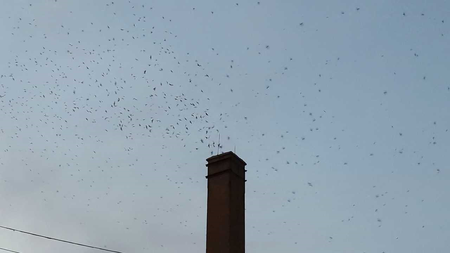
Good Natured: Chimney Swift Migration Season
If you’re someone with FOMO—Fear of Missing Out—the following story might not be for you. On the other hand, if you’re a person who likes to plan ahead—waaay ahead—keep reading, and mark your calendar, for next year…
This week we’re talking about chimney swifts, those delightful little birds that visit us in good numbers from May to September. For the past several months we’ve enjoyed seeing, and hearing, them overhead as they swoop about, chattering constantly as they go about their daily affairs.
But now that fall is here and our weather has cooled, so too has the swift activity. The insects they rely on are also less active, which means it’s time for them to fly.
Like the other fall migrants we’re seeing, chimney swifts are headed south. But unlike some of those other birds, which find the Gulf Coast or Central America good enough, swifts are in it for the long haul. South America to be exact—the upper Amazon basin and the countries of Brazil, Chile, Ecuador and Peru. And remember when we say flying we’re not talking first or business class, or even coach. These guys make that flight completely under their own power.
To fly that distance of roughly 3,000 miles these little (5 in. long, 11 in. wingspan) birds need fuel and plenty of it, in the form of insects. Indeed, these birds are almost, if not entirely, insectivorous, consuming bugs at a rate of about one third of the birds’ body weight each day.
Curious as to what exactly this menu might look like, I did a little flipping through the chimney swift references. I found mentions of flies, beetles, moths and flying ants, bees and wasps—basically, broad groupings of insects that have thousands of species each.
Hoping for greater specificity (and yep, that’s a word. I looked it up!) I turned to our old friend Arthur Cleveland Bent. His great series, Life Histories of North American Birds, contains loads of real-life observations collected from many contributors in the days when keen observation was an art form.
For example, in 1911, W. L. McAtee of the United States Biological Survey wrote that, "(The chimney swift) gets many beetles (Scolytidae), the most serious enemies of our forests, when they are swarming, and takes also the old-fashioned potato beetle (Lema trilineata), the tarnished plant-bug (Lygus pratensis), and other injurious insects. The bird is, of course, largely beneficial to the agricultural interests of the country."
It's important to note that virtually all of this feeding is happening on the fly (the adverb, not the noun, although we’ve certainly established that flies, the nouns, are involved). Bent’s chapter on chimney swifts includes this delightful passage written in 1940 by ornithologist Winsor Marrett Tyler: “The birds have the habit of continual flight during the hours of daylight throughout the summer. They exemplify speed and tireless energy; they sail and circle on set wings, then with flickering wing beats they are off in a burst of speed, shooting like an arrow through the air, chattering their bright notes as they race along--little arrows "cutting the clouds" over country, town, and woodland.”
Tyler makes the birds sound like a show not to be missed, doesn’t he? Well, it gets better.
As night approaches, chimney swifts need to head to a roost—which is to say, a chimney. The birds’ short, weak legs don’t permit perching on tree branches or other horizontal surfaces; instead, these little guys head inside their namesake structure, where they use their strong feet and claws to hang vertically, heads up (as opposed to heads down, which is a bat thing) as they rest and wait for the sun to come up again.
During the summertime, when we see only the swifts that are here raising families, the evening coming-home-to-roost activity can be easily overlooked. But during fall migration, this movement turns into a full-blown phenomenon.
As swifts come down from points north—Wisconsin, Michigan and southern Canada—they congregate in huge numbers in prominent chimneys throughout our area.
You know how when you’re traveling, you like to head to the restaurant with lots of cars? I have a feeling it’s the same with chimney swifts. These birds, most of which are not familiar with our local accommodations, come together to roost by the hundreds and sometimes thousands. In the minutes before and immediately after dusk, they whirl and swirl around the chimney tops then, one by one, dive down. In an important last step, they “helicopter,” or right their bodies so that they end up clinging to the inside walls with their heads facing up. It’s an amazing sight, and one that’s not to be missed.
Well, except, as we mentioned earlier, chimney swift season 2024 is nearly over. But next year is just around the corner. If you’ve got FOMO, or just like to be prepared, mark your calendars for mid April, 2025. That when swift aficionados start scanning the sides for the return of their favorite feathered friends. From there you can watch where they roost (hint: in uncapped, unlined chimneys) and observe their intriguing ways all summer long.
However, if you’re the sort who, instead of reading the whole book, just skims the beginning and middle and then jumps to the ending, write down September 1, 2025. That’s Labor Day, a date that traditionally kicks off swift migration season. That’s just about 330 days away. The countdown starts now!
Pam Otto is the outreach ambassador for the St. Charles Park District. She can be reached at potto@stcparks.org.

